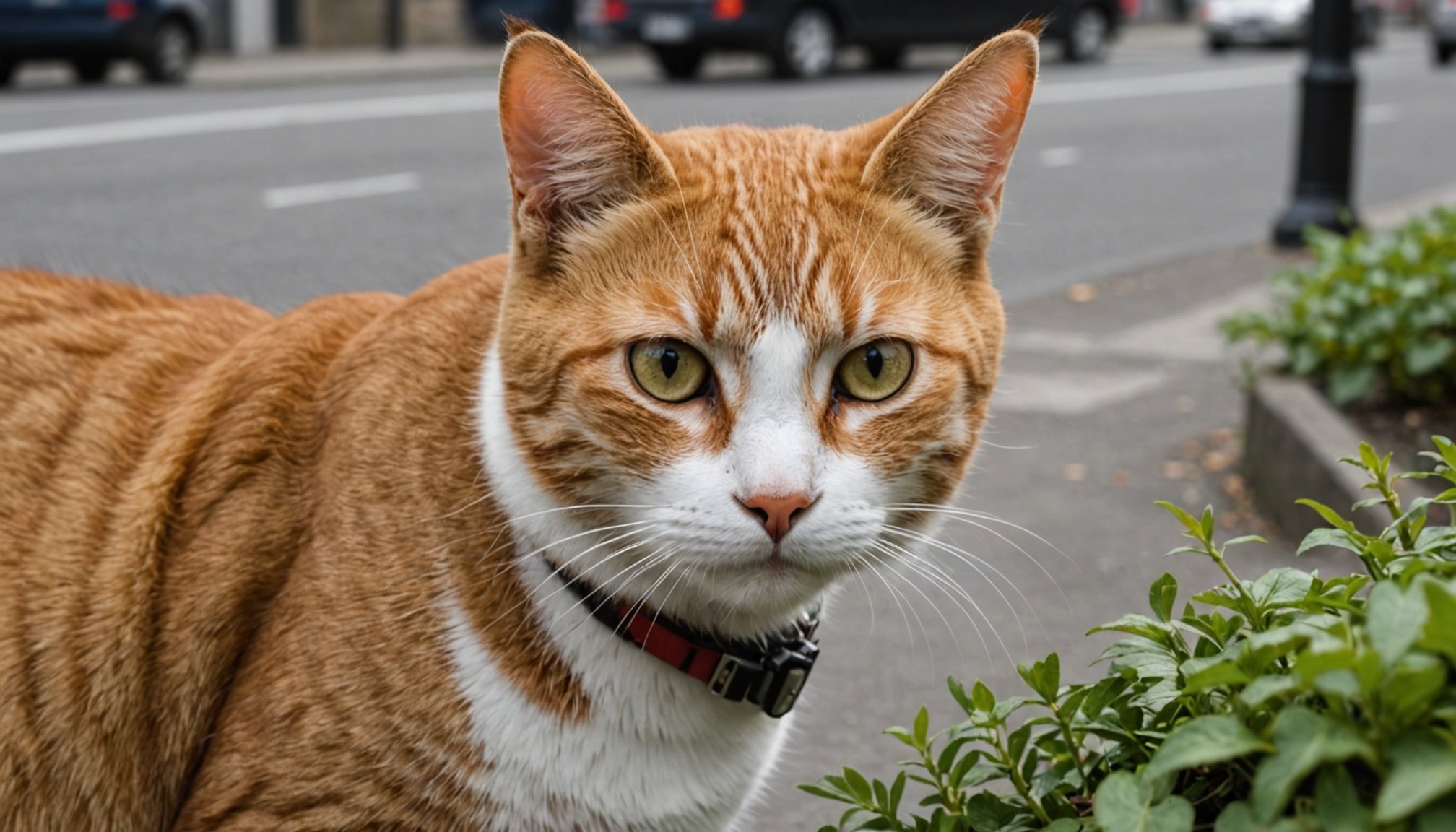Urban roaming cats present unique challenges for pet owners and wildlife alike. GPS collars offer a promising solution for monitoring their movements and behaviors. This technology not only enhances our understanding of cat ecology but also aids in reducing the impact on local ecosystems. Discover how these collars can help manage feline populations effectively while promoting the well-being of urban wildlife. Explore the benefits and limitations of this innovative approach to pet monitoring.
Overview of GPS Collar Technology
Understanding the intricacies of GPS collars can be a game-changer for pet owners. These tracking devices use satellite technology to pinpoint your pet's location, offering peace of mind. The functionality of GPS collars is straightforward: they receive signals from satellites to determine the pet's precise position.
A voir aussi : Delight your child with quality peppa pig plush toys
Different types of GPS collars are available for cats, each catering to specific needs. Some are lightweight and designed for comfort, while others offer additional features like activity monitoring. Advanced models provide real-time tracking, ensuring you always know your pet's whereabouts.
Recent advancements in GPS tracking technology have significantly enhanced these devices. Improvements include better battery life, more accurate positioning, and user-friendly interfaces. These developments make it easier for pet owners to keep track of their furry friends without hassle.
En parallèle : Are Norwich Terriers the Perfect Apartment Companions for City Life in Manchester?
Key Features of GPS Collars
- Real-time tracking: Allows instant location updates.
- Geofencing: Alerts when the pet leaves a designated area.
- Durability: Water-resistant and robust designs for outdoor use.
A relevant quote from a pet owner highlights the impact: "The GPS collar gave me peace of mind knowing my cat's location at all times." This sentiment underscores the importance of reliable tracking devices for pet safety.
Effectiveness of GPS Collars in Tracking Urban Roaming Cats
Understanding how effective GPS collars are in tracking urban cats is essential for pet owners. These devices offer a modern solution compared to traditional methods.
Statistical Success Rates
Research shows that GPS collars have a high success rate in urban environments. A study revealed that over 90% of urban roaming cats were accurately tracked using these devices. This effectiveness is attributed to the advanced technology that precisely locates pets even amidst tall buildings and dense areas.
GPS vs. Traditional Methods
Traditional tracking methods like microchipping and physical searches often fall short in urban settings. Unlike microchips, which require the pet to be found and scanned, GPS collars provide real-time location data. This immediate feedback is crucial in busy urban areas where a cat might wander into dangerous situations.
Case Studies
Several case studies highlight the effectiveness of GPS collars. For instance, a New York City pet owner reported finding their lost cat within hours, thanks to the collar's real-time tracking. Another case in San Francisco demonstrated how a GPS collar helped monitor a cat's roaming patterns, allowing owners to set safe boundaries.
"With a GPS collar, I no longer worry about my cat disappearing in the city," a satisfied user shared.
Behavior and Movement Patterns of Urban Roaming Cats
Understanding the behavior and movement patterns of urban roaming cats offers valuable insights into their daily lives. GPS collars provide a wealth of data, capturing the intricacies of feline behavior in bustling city environments.
Insights from GPS Data
GPS data reveals that urban cats often establish movement patterns that reflect their adaptation to city life. These patterns include navigating through alleyways, parks, and even rooftops. By analyzing GPS data, pet owners can identify their cats' preferred routes and resting spots, enhancing their understanding of feline behavior in urban settings.
Impact of Urban Settings
Urban environments significantly influence cat behavior. The presence of traffic, noise, and human activity shapes how cats move and interact with their surroundings. For instance, GPS data shows that urban cats tend to be more cautious and exhibit shorter travel distances compared to their rural counterparts.
- Key Observations:
- Cats often roam during quieter hours.
- They establish territories that avoid high-traffic areas.
- Interaction with other urban wildlife is minimal.
"GPS tracking has unveiled a hidden world of urban cat behavior," notes a researcher, emphasizing the importance of understanding these movement patterns for better pet care.
This information is crucial for pet owners aiming to ensure their cats' safety and well-being in urban landscapes.
Benefits for Pet Owners
Understanding the advantages of GPS collars for pet owners can significantly enhance their peace of mind.
Enhanced Safety and Security
For pet owners, ensuring the safety of their furry companions is paramount. GPS collars provide real-time tracking, allowing owners to instantly locate their pets, thus reducing the anxiety associated with lost pets. This technology ensures that pet owners can quickly respond to potential threats, such as busy streets or unfamiliar territories.
Monitoring Health and Activity Levels
GPS data offers insights into your pet's daily activities, which is crucial for maintaining their health. By tracking movement patterns, pet owners can monitor exercise levels and identify any changes in behavior that might indicate health issues. This proactive approach helps in keeping pets healthy and active.
Emotional Benefits
Knowing a pet's location at all times brings emotional relief to pet owners. This peace of mind is invaluable, as it allows them to focus on other aspects of life without the constant worry about their pet's whereabouts.
- Key Benefits for Pet Owners:
- Real-time location updates
- Enhanced pet safety
- Improved health monitoring
"Having a GPS collar is like having an extra pair of eyes on my pet," a pet owner expressed, highlighting the emotional security these devices provide.
Insights from Veterinarians
Exploring expert opinions on GPS collars for health monitoring
Veterinarian Perspectives
Veterinarians offer valuable insights into the benefits of GPS collars for pet health monitoring. Many experts agree that these devices can play a crucial role in tracking a pet's activity levels, which is essential for maintaining overall health. By analyzing data from GPS collars, veterinarians can identify patterns that may indicate potential health issues, such as decreased activity or erratic movements.
Recommendations for Pet Owners
For pet owners considering GPS collars, veterinarians recommend selecting models that prioritize comfort and fit. Ensuring that the collar is not too tight or heavy is crucial to prevent discomfort or potential injuries. Additionally, experts advise regular checks to ensure the collar's functionality and battery life remain optimal.
- Key Recommendations:
- Choose lightweight, adjustable collars
- Regularly monitor collar fit and battery
- Consult with a veterinarian for tailored advice
Potential Health Concerns
While GPS collars offer numerous benefits, veterinarians caution about potential health concerns. Prolonged use of poorly fitted collars can lead to skin irritation or pressure sores. It's essential for pet owners to remain vigilant and address any signs of discomfort promptly. Regular consultations with veterinarians can help mitigate these risks and ensure the pet's well-being.
Impact on Urban Wildlife
Exploring the ecological implications of cat roaming in urban settings
Cat Predation Rates in Urban Areas
Research highlights the significant ecological impact of domestic cats on urban wildlife. Cats are natural predators, and their presence in cities can disrupt local ecosystems. Studies indicate that urban cats contribute to the decline of small mammal and bird populations. This cat predation is a growing concern among ecologists who strive to balance pet safety with wildlife protection.
GPS Data Contributions to Wildlife Conservation
GPS collars offer valuable insights into the predatory behavior of urban cats. By tracking their movements, researchers can identify areas where cats frequently hunt. This data is crucial for wildlife conservation, allowing authorities to implement measures that protect vulnerable species. For instance, establishing cat-free zones in critical habitats can mitigate the adverse effects on urban wildlife.
Balancing Pet Safety with Wildlife Protection
Pet owners must navigate the delicate balance between ensuring their pet's safety and preserving urban wildlife. GPS collars can aid in this effort by enabling owners to monitor their cats' activity and restrict access to sensitive areas.
- Key Considerations:
- Implementing geofencing to limit roaming
- Encouraging indoor activities during peak wildlife hours
- Supporting local conservation efforts
"Understanding the ecological impact of our pets is vital for harmonious urban living," an ecologist remarked, emphasizing the need for responsible pet management.
Selecting the Right GPS Collar
Choosing the ideal GPS collar for your pet involves careful consideration.
Key Features to Consider
When selecting a GPS collar, prioritize features that align with your pet's needs. Consider real-time tracking, battery life, and durability. Lightweight designs are crucial for comfort, especially for smaller pets. Some models offer additional features like activity monitoring, which can provide insights into your pet's health.
Comparison of Popular Brands and Models
Several brands offer reliable GPS collars with varying features and price points. Here is a comparison of popular options:
| Brand | Key Features | Price Range |
|---|---|---|
| Brand A | Real-time tracking, waterproof | $50 – $100 |
| Brand B | Long battery life, geofencing | $100 – $150 |
| Brand C | Lightweight, activity monitoring | $150 – $200 |
Cost Considerations and Value for Money
Cost is a significant factor when selecting a GPS collar. While higher-priced models often offer more advanced features, it's essential to assess whether these extras provide real value for your specific situation. Evaluate the value for money by considering how often you will use the collar's features and the potential peace of mind it offers.
Practical Tips for Usage
Integrating GPS collars into your pet's routine requires thoughtful application.
Guidelines for Fitting and Adjusting GPS Collars
When it comes to usage tips, ensuring a proper fit is crucial for your pet's comfort and safety. The collar should be snug but not too tight. A good rule of thumb is to leave enough space to fit two fingers between the collar and your pet's neck. Regularly check for signs of wear or discomfort, adjusting as needed to maintain optimal performance.
Maintenance and Charging Tips for Optimal Performance
To keep the GPS collar functioning effectively, follow these maintenance tips. Clean the collar regularly to prevent dirt buildup. Ensure the charging port is free of debris for efficient charging. Charge the collar as per the manufacturer's instructions, and keep a consistent schedule to avoid unexpected power loss.
Tips for Integrating GPS Tracking into Daily Routines
Incorporating GPS tracking into your daily routine can be seamless with these best practices. Set up geofencing alerts to receive notifications if your pet leaves their designated area. Review activity data regularly to monitor your pet's health and behavior patterns.
- Key Usage Tips:
- Regularly adjust for comfort
- Maintain a charging schedule
- Utilize geofencing features
"Consistent maintenance ensures our GPS collar works flawlessly," a pet owner shared, highlighting the importance of upkeep.
User Experiences and Testimonials
Exploring real insights from pet owners using GPS collars.
Summary of User Feedback
User experiences with GPS collars highlight both their effectiveness and areas for improvement. Many pet owners appreciate the peace of mind these devices offer, citing real-time tracking as a game-changer. However, some users have noted issues such as limited battery life and occasional inaccuracies in tracking.
Positive and Negative Experiences
Pet owners have shared a variety of experiences. Positive testimonials often mention the reliability of real-time alerts and the ease of integrating these devices into daily routines. Conversely, negative feedback sometimes focuses on technical glitches or discomfort for pets due to ill-fitting collars.
- Key Observations:
- Real-time tracking praised for accuracy
- Some users report battery life concerns
- Fit and comfort issues noted by a few owners
Notable Case Studies
Several case studies illustrate the practical benefits of GPS collars. For instance, a pet owner in Chicago recounted how a collar helped locate their cat within minutes after it wandered into a neighbor's yard. Another case involved a rural dog owner who used GPS tracking to monitor his pet's activity levels, leading to improved health management.
"The GPS collar was a lifesaver when my cat went missing," shared a relieved user, emphasizing the device's utility in critical situations.
Future Trends in GPS Tracking for Pets
Exploring the next wave of innovations in pet tracking technology.
Emerging Technologies in GPS Tracking
The landscape of GPS tracking for pets is on the brink of transformation, driven by cutting-edge technology advancements. Emerging technologies like IoT (Internet of Things) and AI (Artificial Intelligence) are set to revolutionize pet tracking devices. These advancements promise more precise location data and enhanced functionalities.
Predictions for the Future of Pet Tracking Devices
Looking ahead, future trends suggest that pet tracking devices will become more integrated with smart home systems. This integration will allow pet owners to monitor their pets' movements through connected devices such as smartphones or smart speakers. Additionally, technology advancements are expected to lead to smaller, more comfortable collars with extended battery life.
Potential Improvements in GPS Collar Features
As technology advancements continue, we can anticipate significant improvements in GPS collar features. Potential enhancements include solar-powered charging options, biometric monitoring for health insights, and even augmented reality interfaces for real-time pet location visualization. These innovations will make pet tracking more efficient and user-friendly.
- Key Future Trends:
- IoT and AI integration
- Smart home compatibility
- Biometric and solar-powered features
"The future of pet tracking is not just about location—it’s about understanding and enhancing the pet-owner relationship," an industry expert remarked.











